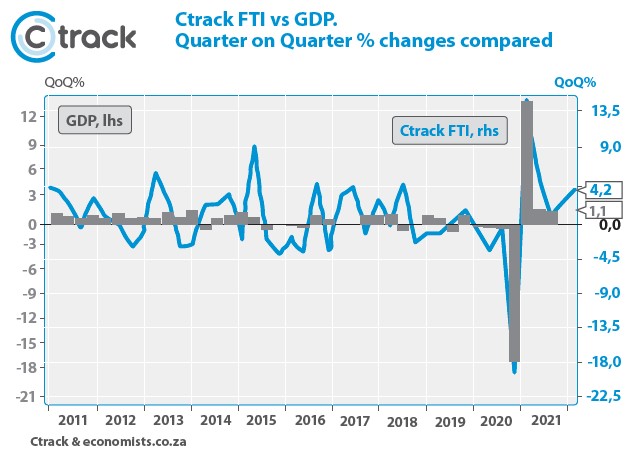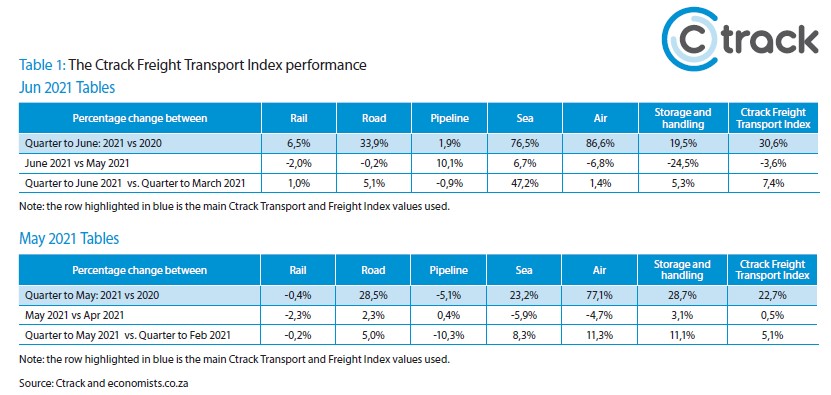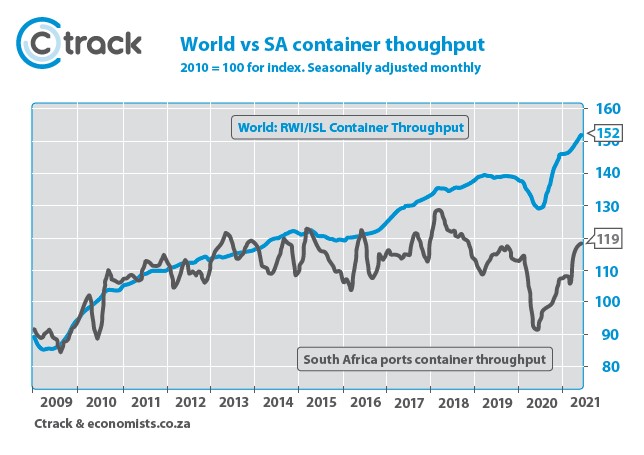According to the latest Ctrack Freight Transport Index, the overall logistics sector continues to show huge growth with year-on-year increases of 26.4 percent.
The quarter-on-quarter improvement in the index bodes well for the second quarter GDP growth at present. Economic activity was relatively strong in the second quarter, although some of the improvement was due to higher export prices and some catch-up of other economic activity after the harder lockdown in the first quarter.
“While growth in the majority of sectors measured by the Ctrack Freight Transport Index is great to see, unfortunately, a variety of external factors will see this growth remain stagnant or even decline in the short term,” says Hein Jordt, Managing Director of Ctrack SA.
However, it is expected that the recent stricter lockdown measures may have had a negative impact on the service portion of the country’s GDP, so only time will tell if the freight transport and GDP relationship remained as is during the second quarter.
Road, sea freight
Measuring the changes in the activity of the different transport sectors over a two-year period indicates that the majority of the sub-sectors measured by the index have not yet returned to pre-COVID-19 levels. Only road freight has fully recovered and surpassed previous levels, mainly to the detriment of rail freight, which still struggles along.
Rail transport is still about 16 percent off its previous highs due to factors such as some derailments on the coal line and some problems on other lines that continue to hurt the sector.
Sea freight is very near to previous levels, and that is encouraging. Overall, the freight logistics sector is still about 3 percent away from its prior highs.
The current performance of the index is based on data from June, and it is expected that the looting and Level 4 restrictions experienced during July will have a negative effect on various sectors, including air and sea freight, and naturally road and rail freight too.
The recent closing of the N2 and N3 and Transnet ports due to looting and unrest will most definitely mean that the index for those sectors will show month on month declines in July and August.
The effects that the recent unrest will have on the entire transport sector are concerning. Theknock-on effect of road and port disruptions will include negative impacts on rail, pipelines and perhaps even air freight. The effects of the riots and lockdown Level 4 have not yet been felt, and we will have to wait for the July numbers before we can truly ascertain what effect it all will have on the transport industry.
“While the recent unrest was frightening to see, it once again highlights the need for a reliable tracking and fleet management solution. Ctrack offers a wide variety of bespoke solutions for every industry. These solutions will ensure that vehicles and cargo are always visible and contribute to increased safety and ability to plan around any delays,” adds Jordt.
SA container traffic
Since 2010, South African container throughput has increased by 19 percent. A 19 percent improvement in 11 years is a far performance from the overall SA economy, which only experienced an increase in GDP of 3.6 percent over the same period, reveals the index.
This growth is partly because containers are becoming increasingly popular for the international transportation of goods as containers can easily be transported by various modes.
In the quarter ending in June, South African ports handled over 13,000 TEUs a day. TEU represents a twenty-foot equivalent unit, meaning that the actual number of containers could be far less with many containers these days of the fortyfoot size. Regardless, this still represents a figure of at least 6,500 containers a day.
More than half the total containers passing through South Africa are handled by the port of Durban, which moves approximately 4,150 containers per day. This equates to three containers a minute that need to move in the port of Durban.
While the numbers are impressive, it shows the serious problems Transnet Port Terminals (TPT) faces when it must do manual loading and sorting due to factors such as a recent computer hack. The recent delays at the ports will have a further negative effect on the road and rail freight sectors, which will, in turn, have a negative effect on the overall Ctrack Freight Transport as well as the South African economy as a whole.
While South African container throughput has grown admirably at 19 percent in the last 11 years, this is well below the global average. Global container throughput has increased by 52 percentover the same period. Slow growth compared to the global average indicates that exports from South Africa are not growing in volume at a satisfactory rate.
An additional contributing factor is that South Africans have become poorer in real per capita income. The country can no longer afford as many imports as was possible before 2014, and this has also had an impact on the throughput of containers. Much of South Africa’s current good export performance is due to high commodity prices rather than improved or more efficient production. “In other words, South Africa is slowly losing out on global opportunities,” says Jordt. •




.png)


